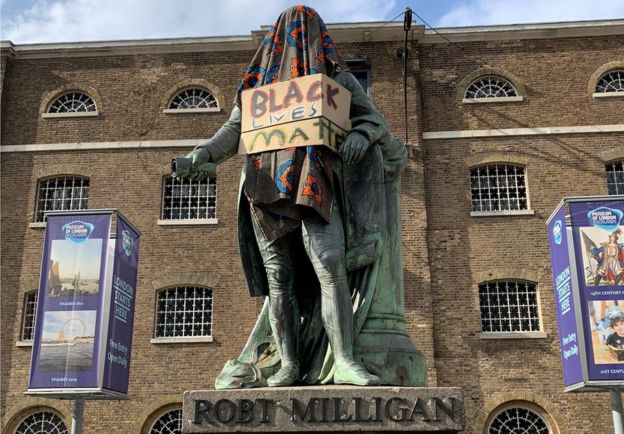Some media commentators and politicians have been surprised by the strength of the reaction, in Britain, to the murder of George Floyd in the US. But there is no cause for bewilderment. For the large numbers of people who are organising, rallying, protesting and sometimes bringing down statues, are also busy making connections which inform their protests. They are aware that Britain is not the US, and in particular, that the population of this country does not include a large minority of people who are the descendants of slaves- or at least, not of slaves who lived in this country. But they are also well aware that the slave ships which took black men and women from Africa to the US and the Caribbean islands very often sailed under British flags, and that British merchants- including Edward Colston and Robert Milligan- made fortunes from their human trafficking. They are aware that the British state was fattened on the colonial profits derived from its coercive and often violent rule over its distant subjects in Africa, India and elsewhere in the world. They are making other links too. They observe that Britain’s greatest cities are awash with statues of slavers (often euphemistically described in plaques as ‘West India merchants’) and celebrations of those who ruled despotically over Britain’s colonial subjects, but hardly any commemorations of slavery or the sufferings of colonial subjects. They remind us that Britain’s murder and exploitation of black and brown people mostly happened overseas- easier to ignore and forget, but no less real for that. They draw attention to other indisputable facts, including the racialized character of income inequality, incarceration rates, and health outcomes (brutally highlighted by the Covid-19 crisis) in the UK as in the US, and the indelible stain of authority and power that statues leave on the landscape, marking public space as hostile to some Britons even before stop and search policies bring that home in physically embodied ways.
Joining the dots is the first step towards seeing patterns where once there were only isolated facts and unhappy coincidences. As it begins to put together seemingly disparate historical events, the movement against racism begins to range more broadly and widely, noting that the dispossession and genocide of the indigenous peoples of the Americas and Australia is part of the same historical canvas that gives rise to the injustices that their struggles are directed against; and that the borders by which the US seeks to seal itself off from Latin America, and Europe from north Africa, do not separate the civilised from the uncivilised or democracies from autocracies, but rather separate the privileged from those whose labour has been the source of many of their privileges. Observing these protests in the UK and elsewhere, one feels like one is watching not only a mass movement, but one that doubles up as a classroom- one crackling with intellectual energy. The protestors, many of them young and yet mature beyond their years, are making linkages between the history of colonialism and slavery and the structural racism which is its legacy. They are doing so despite, rather than because, their education has equipped them to make such connections. The street is their classroom because their classrooms have failed them.
We have spent over a decade at Goldsmiths overhauling the courses we teach so that many of them link contemporary issues and struggles- including Black Lives Matter, the politics of statuary, and the numerous struggles against neocolonialism in the Global South- with the histories of conquest and colonialism that have made them necessary. In doing so we have been struck and gratified by the eagerness, the thirst, with which our students debate colonialism, race, slavery, conquest and dispossession. Sometimes we have felt as if we were not so much teaching, as providing the raw materials which enable our students to make sense of their lived experience, and translate it into action. At other times our pupils have become our teachers, as during the remarkable occupation of Goldsmiths in 2019, when students demanded that the institution confront and address its own complicity in the reproduction of structural racism.
This is despite the fact that our students usually come to us having scarcely encountered this history in the course of their schooling, for incredibly, it is possible to study history and politics at school and barely confront Britain’s imperial past. This makes them all the more eager to learn of this past, and to connect it with their, and our, present. Nor is this just because almost half our student body are black, Asian or ethnic minority British; as with the protestors, our most passionate students are as likely to be white as black or Asian.
The activists engaged in this struggle are drawing connections, just as our students, many of them active in the movement, have been doing in the classroom. As teachers we have merely taught that the classroom and the street are seamlessly joined; the activists of Black Lives Matter and other organisations are demonstrating this to be so. On the basis of our experience as university teachers, we are not surprised that the murder of George Floyd in the US has injected renewed energy into the movements against racism worldwide, not least in Britain. No grounds for shock or surprise here.
The authors of this article direct the Centre for Postcolonial Studies at Goldsmiths, University of London.
Image credits: The statue of Robert Milligan was covered with fabric and Black Lives Matter sign before being removed. Wikpedia.
[vc_row][vc_column][vc_text_separator title=”ABOUT THE AUTHORS” color=”juicy_pink”][vc_column_text][authorbox authorid = “161”][/authorbox]
[vc_column_text][authorbox authorid = “160”][/authorbox]
[vc_column_text][authorbox authorid = “159”][/authorbox]
